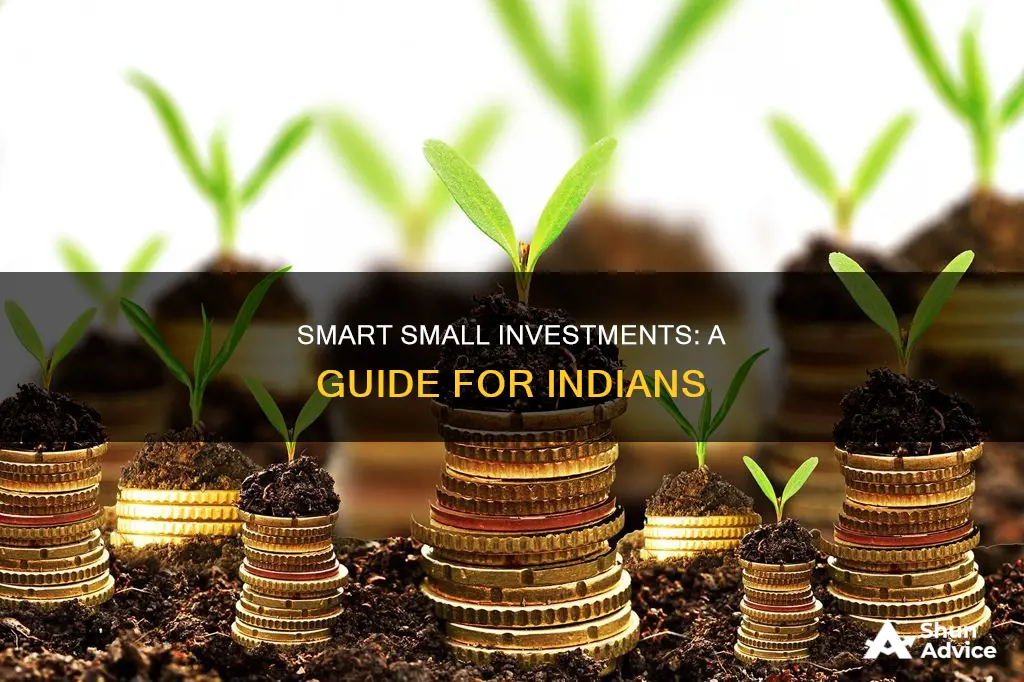
India offers a plethora of investment opportunities for individuals with varying risk appetites. From low-risk ventures such as fixed deposits and government bonds to high-risk investments like direct equities and hedge funds, there is something for everyone. Mutual funds, gold, real estate, and stocks are also popular choices. For those with a small budget, options like Systematic Investment Plans (SIPs) in mutual funds, government savings schemes, and dropshipping businesses are worth considering. Understanding your risk profile, performing thorough research, and diversifying your portfolio are key to making smart investments.
| Characteristics | Values |
|---|---|
| Risk | Low, Medium, High |
| Investment Options | Mutual Funds, Insurance and Government Schemes, Gold, High-Yield Accounts, Fixed Deposits, Stocks, Exchange-Traded Funds, Real Estate, Bonds, Saving Schemes, SIP Mutual Funds, ULIPs, REITs, National Savings Scheme, Post Office Time Deposit, Kisan Vikas Patra, Cryptocurrencies |
| Investor Profile | Age, Financial Situation, Job Security |

Mutual funds
Step 1: Start with risk profiling
Firstly, you need to understand your risk tolerance and capacity. Knowing the amount of risk you can take before investing in mutual funds is essential. Your risk profile is built on the basis of your age, financial situation, and job security. For instance, a younger individual with a secure job is able to invest for longer in smaller increments.
Step 2: Asset allocation
After completing the risk profiling, the next step is asset allocation, where you divide your money between various asset classes. Asset allocation should include a mix of equity and debt instruments to balance the risk factors.
Step 3: Identify funds
The third step is to identify funds that invest in each asset class. Then, you can check for past performance or investment objectives for comparing mutual funds.
Step 4: Select a mutual fund scheme
Select the mutual fund scheme you will invest in and start the application either online or offline.
Step 5: Diversify your investments
Diversifying your investments and regular follow-ups are essential to ensure better results and higher profits.
How to invest in mutual funds
You can invest in mutual funds in India in several ways, depending on your preferences and convenience. Here are some options:
- Through a mutual fund distributor: AMFI-registered mutual fund distributors provide financial advice and help investors with transactions. Distributors are paid commissions by the fund house and do not charge any fee from investors.
- Directly with the Asset Management Company (AMC): You can invest directly with the AMC by visiting their office or through their online portal. If you are a new investor, you need to submit your Know Your Client (KYC) documents either at the AMC office or online.
- Through Registered Investment Advisors (RIA): You can invest through SEBI Registered Investment Advisors (RIA). RIAs do not get commissions from Asset Management Companies and may charge a fee for their services.
- Through Registrars and Transfer Agents (RTAs): RTAs process mutual fund transactions on behalf of fund houses. You can invest in direct and regular plans through the RTAs. One benefit of investing through RTAs is that you can view your portfolio of mutual fund schemes of the AMCs serviced by the RTA in one place.
- Online: You can invest through online portals, mobile apps, or websites of AMCs, RTAs, or mutual fund distributors.
- Through a stockbroker: Stockbrokers providing online trading and demat services also offer online investment in mutual funds.
- Through your bank: Most banks offer wealth management services through which you can invest in mutual funds.
Things to keep in mind
- You can invest in mutual funds only from your own bank account through cheque or online banking. You can also invest in cash but only up to a maximum limit of Rs 50,000 in a financial year.
- Third-party transactions are not allowed in mutual funds. Your name should be printed on the cheque leaf, or you should be the account holder of the savings bank account if you are making payments using online banking.
- You can invest jointly with your spouse if the investment is made from a joint account where both you and your spouse are account holders.
- You can invest on behalf of your minor child, provided your child is the sole account holder represented by the parent/guardian. Once a child turns 18, the parent/guardian needs to change the status of the sole account holder from Minor to Major.
- You must be KYC compliant before investing in mutual funds. To be KYC compliant, you need to have the following documents: a recent passport-sized photograph, proof of identity (e.g. passport, PAN card), a copy of your PAN card, and proof of address (e.g. Aadhaar card).
Home Investment: A Smart Portfolio Move?
You may want to see also

Government schemes
India's government has introduced numerous investment schemes to cater to the diverse financial needs of its citizens. These schemes are designed to meet various financial goals, from retirement planning to child education, and offer a range of benefits such as guaranteed returns, tax exemptions, and long-term security. Here is a detailed overview of some of the top government schemes available for small investments in India:
Atal Pension Yojana (APY)
Atal Pension Yojana is a government-backed pension scheme designed for individuals working in the unorganized sector, such as gardeners, helpers, and workers. The scheme aims to provide financial security to those who may not have access to traditional retirement plans. With APY, individuals can make fixed contributions each month, quarter, or half-year and receive a guaranteed pension upon reaching 60. The eligibility criteria include being aged between 18 and 40 years and having a savings bank account or post office savings account. The monthly pension ranges from ₹1,000 to ₹5,000, depending on the contribution amount and age of the subscriber. APY also offers tax benefits under Section 80CCD of the Income Tax Act.
Post Office Monthly Income Scheme (POMIS)
The Post Office Monthly Income Scheme is a low-risk investment option offered by the Indian Postal Service. It provides investors with a fixed monthly income on their deposits, making it attractive for those seeking regular income streams. The scheme offers an interest rate of 7.4% per annum as of April 2024. It is open to Indian citizens, minors (through guardians), and joint accounts with a minimum investment of ₹1,000 and a maximum of ₹9 lakh for a single account or ₹15 lakh for a joint account.
Kisan Vikas Patra (KVP)
Kisan Vikas Patra is a government savings scheme offered by the Indian post office since 1988. It is designed to promote long-term financial discipline, with a tenure of approximately 113-115 months (9-9.5 years). KVP offers a guaranteed return, with a minimum investment of ₹1,000 and no upper limit. The interest rate is currently fixed at 7.5% as of April 2024. The scheme is open to all resident Indians, including minors (through guardians), and the interest earned is exempt from Tax Deducted at Source (TDS).
National Pension Scheme (NPS)
The National Pension Scheme is a voluntary, market-linked retirement savings scheme regulated by the Pension Fund Regulatory and Development Authority (PFRDA). NPS allows individuals to build a retirement corpus through regular contributions throughout their working lives. It is open to Indian citizens (residents and non-residents) aged between 18 and 65 years. NPS offers Tier I (retirement savings) and Tier II (voluntary savings) accounts, providing flexibility in asset allocation choices. Investments of up to ₹1.5 lakh can be exempted from taxation, and up to 60% of the corpus can be withdrawn as a lump sum at maturity.
National Savings Certificate (NSC)
The National Savings Certificate is a government-backed fixed-income investment scheme available through post office branches. It targets small to mid-income investors, offering both savings and tax savings benefits. NSC is open to Indian citizens, with no age limit, while NRIs are not eligible to invest. The minimum investment amount is ₹100, with no maximum limit, and the current interest rate is 7.7% per annum as of April 2024. Investments of up to ₹1.5 lakh are eligible for tax deductions under Section 80C of the Income Tax Act.
Public Provident Fund (PPF)
The Public Provident Fund is a long-term government investment scheme that promotes small investments with reasonable returns and tax benefits. PPF accounts can be opened by any Indian citizen, including on behalf of minors, and are operational online as well. The minimum deposit is ₹500 per year, with a maximum of ₹1.5 lakh per financial year. The current interest rate is 7.1%, and deposits qualify for tax deductions under Section 80C. The scheme has a lock-in period of 15 years, with partial withdrawals allowed from the 7th year and loan facilities available from the 3rd to 6th financial years.
Senior Citizens Savings Scheme (SCSS)
The Senior Citizens Savings Scheme is a government-backed retirement program designed for senior citizens aged 60 and above. It offers regular income, safety, and tax-saving benefits. The scheme is also open to retired individuals between 55 and 60 years of age. The minimum investment amount is ₹1,000, with a maximum of ₹30 lakh. The interest rate is currently 7.4% per annum, and tax deductions of up to ₹1.5 lakh are available under Section 80C. The scheme has a 5-year term, which can be extended by another three years.
Sukanya Samriddhi Yojana (SSY)
The Sukanya Samriddhi Yojana is a government investment scheme specifically designed for the girl child's education and future. It was launched under the 'Beti Bachao, Beti Padhao' campaign. The scheme offers an attractive interest rate, currently at You may want to see also One of the main benefits of investing in gold bonds is that they eliminate the risks and costs associated with storing physical gold, such as theft, burglary, and storage charges. Additionally, gold bonds are free of GST charges, which further enhances their attractiveness as an investment option. When investing in gold bonds, it is important to note that there are minimum investment requirements. For Sovereign Gold Bonds, the minimum investment amount is approximately the price of 1 gram of gold, which is usually around ₹5,000. In terms of liquidity, gold bonds can be redeemed before maturity through premature encashment after the completion of the five-year lock-in period. Alternatively, investors can sell their bonds in the secondary market at any time after six months from the date of issue, although this may be at a discount to the market price of gold due to the low volumes in the secondary market. Overall, gold bonds are a secure and convenient way to invest in gold, offering capital appreciation, assured interest income, and tax benefits. They are particularly suitable for those planning to invest for an extended period (5+ years) and seeking regular interest payouts. You may want to see also You may want to see also Types of Fixed Deposits Benefits of Fixed Deposits Drawbacks of Fixed Deposits Eligibility and Documentation for Fixed Deposits To open a fixed deposit account in India, individuals must meet the eligibility criteria and provide necessary documentation. The following entities are eligible to open FD accounts: The required documents typically include proof of identity and residential address, such as a Post Office-issued ID, Aadhaar card, passport, voter ID, driving license, utility bills, etc. Senior citizens and minor investors may also need to submit age proof documents, such as a birth certificate or matriculation certificate. You may want to see alsoSavings vs Investments: When Does Saving Trump Spending?

Gold bonds
MFS Investment Management: Paying Primary Beneficiaries

High-yield savings accounts
India's Infrastructure: A Guide to Investing in its Future

Fixed deposits
Alternative Investment Management: Exploring Non-Traditional Strategies
Frequently asked questions







